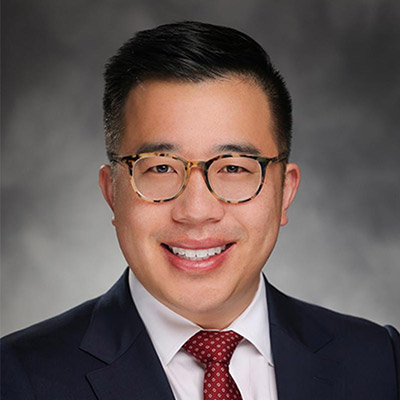Awake spinal surgery, which allows patients to undergo certain minimally invasive spine procedures without general anesthesia, is opening the doors to surgical benefits for more patients with spine conditions.
At NewYork-Presbyterian and Columbia, Andrew K. Chan, M.D., a neurological spine surgeon and director of minimally invasive spine surgery, is advancing the use of the procedure at NewYork-Presbyterian Och Spine Hospital, where he has completed four successful awake spinal surgeries among elderly patients.
The surgery itself is the same for an awake procedure but instead of receiving general anesthesia, patients receive a combination of a spinal anesthetic, which numbs the patient’s lower body, as well as local anesthetic and additional medication before, during, and after the procedure.
“The question is, can we do the same surgery without general anesthesia?” says Dr. Chan. “The answer is yes. We do the same surgery, complete it, and then wait for the patient to regain feeling from their waist down. After awake spine surgery, our patients go home the same day, and we can spare the intubation and the cognitive side effects of all the medications you need for general anesthesia.”
Dr. Chan’s goal is to expand awake spine surgery to patients who require spinal procedures but can’t tolerate general anesthesia, including elderly patients and patients with cardiac comorbidities. Taking away general anesthesia means eliminating the risks associated with inserting the breathing tube, which can cause trauma for patients and potentially damage the teeth. It also removes the risk of cardiopulmonary complications, such as hemodynamic instability and cardiac dysrhythmias that can arise during general anesthesia induction.
Awake spine surgery relies on a close relationship with our anesthesia team. If you don’t have their buy-in and people who know how to do a spinal anesthetic, it’s not a good idea.
— Dr. Andrew K. Chan
Dr. Chan works closely with the anesthesia team at Och Spine at NewYork-Presbyterian to figure out what type of pain relief will be appropriate for each patient and procedure, usually some combination of spinal anesthesia, local anesthetics, and sedation. It’s critical to have an anesthesia team that is experienced with awake procedures, he says. “Awake spine surgery relies on a close relationship with our anesthesia team. If you don’t have their buy-in and people who know how to do a spinal anesthetic, it’s not a good idea,” Dr. Chan says.
Awake surgeries are best suited for minimally invasive procedures. “Doing open surgery is not really an option,” he says. “There’s just too much muscular dissection and pain that occurs, among other factors.”
Dr. Chan says patients can be awake during surgery for several types of lumbar spine procedures including:
- Nerve pinching
- Spinal instability
- Laminectomy
- Discectomy
- Minimally invasive transforaminal lumbar interbody fusion
- Sacroiliac junction fusion
- Other lumbar degenerative issues
However, some procedures, such as a large spinal deformity correction, would not be appropriate for an awake procedure because the surgery is too lengthy. Currently, awake spine procedures need to be under three hours because that’s how long the spinal anesthetic lasts.
Choosing the Right Patient
Selecting the appropriate patient for awake spine surgery is critical. The first question is whether patients are even willing to consider being conscious during surgery. “You have to get them to imagine the situation. ‘You’re going to have your face in something that looks like a massage table and things are going to be happening all around you. You’ll be hearing people talking about surgery and hearing drills. Does that sound okay to you?’” Dr. Chan says. “You can get a sense of when that doesn’t sound good to the patient, or it sounds like a great idea for the patient.”
Some patients are not medically appropriate for awake spinal surgeries, such as patients who are severely obese, have chronic obstructive pulmonary disease, and those with obstructive sleep apnea.
Once patients get into the operating room, the team tries to make them more comfortable by playing their favorite music, whether that’s opera or jazz. Dr. Chan says he also lets patients know what’s happening in real time, explaining some of the sounds they might hear during surgery. But some patients are so relaxed during the procedure, they fall asleep, even without general anesthesia. “Sometimes they doze off and start snoring,” he says.
To date, Dr. Chan and his team have performed four successful awake spine surgeries, three in patients in their late 80s and 90s. The first case was an 89-year-old with chronic back pain who required spinal microdecompression surgery. Another patient opted for the awake procedure because they had Parkinson’s disease and general anesthesia would have worsened their cognitive symptoms. The oldest patient, at 94 years old, underwent a joint fusion procedure without general anesthesia.
Improved Pain and Post-Operative Recovery
Patients report that they feel no pain during the awake procedure and little to no pain after the surgery. Part of the reason for the swift recovery is that they don’t experience the temporary perioperative confusion often seen with patients who receive general anesthesia. “It’s a very pleasant experience and you feel very ready to go home, like you barely had surgery,” Dr. Chan says.
If they can do the surgery without going through general anesthesia, I think this will help these specific patients get the surgery needed to help improve their quality of life.
— Dr. Andrew K. Chan
Dr. Chan predicts that more people, including younger patients, will opt for awake spinal surgery in the future to avoid general anesthesia. “There are probably a lot of patients out there that are afraid of doing surgery because of general anesthesia,” he says. “If a patient is hesitant about surgery, I often ask why they don’t want surgery. Interestingly, some say that the anesthesia itself is the concern. If they can do the surgery without going through general anesthesia, I think this will help these specific patients receive the surgery needed to improve their quality of life.”




